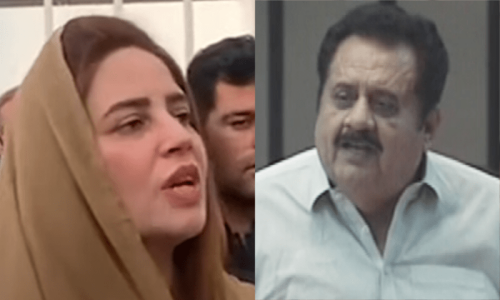
This year the return of Hassan Jehangir’s ‘Hawa Hawa’ in Bollywood flick Chaalis Chaurasi and Nazia Hassan’s ‘Disco Deewane’ in Karan Johar’s Student of the Year pinpoints the timeless and classic appeal of Pakistani pop numbers which, from time to time, have filtered across the border, created waves and made box office hits out of mediocre films.
Perhaps it was Ahmed Rushdi’s ‘Ko-Ko-Korina’ in 1966 or Runa Laila’s film and TV song (and dance) in the early ’70s that set the tone for Pakistani pop music culture but it was not until 1973 when a skinny, young fellow, casually strumming his guitar in PTV’s Sunday ke Sunday, a show hosted by the late Moin Akhtar, sang Albela rahi, and caught everyone’s eye. It was a voice and a style that Pakistani audiences had not witnessed before.
With Albela rahi which was translated from a famous Cuban hit originally in Spanish, Alamgir heralded the era of pop music for Pakistan, a new form of music that blended the classical forms with a tint of modern western music. He sang, he danced, and young and old loved his music. Dekha na tha was a sensation followed by Dekh tera kya rang kar dia hai, Dil kay sab raastay, Jugni, Kabhi tum idhar se guzar kay to dekho, Keh dena, Khwabon mein main bhi akela, Mere geeton ki jhankaar tu to name a few. Hit after hit, he proved to be an icon, the most successful singer and musician of his time.
He would wear chunky belts, and Gary Glitter and Elvis Presley-inspired costumes. Lights flashed, cameras went mad zooming in and out, drummers went ballistic, concerts happened and Alamgir even fell off the stage during a high charged performance. It was obvious that Pakistanis were ready for a pop revolution and other singers were quick to take the cue.
It wasn’t long before Mohammed Ali Shyhaki appeared on the scene during an election transmission when colour TV was still new to Pakistani audiences. PTV produced a rather artistic backdrop with what was supposed to be a huge face carved in a dark rock in front of which a young man sang Meri ankhon se iss dunya ko dekho. Alongside Alamgir, this lean fellow of Iranian origins produced several hits like Pyar kiya meine dil diya, Jaan bohat sharminda hain, Ye mausam aa zara dekh le followed by the unforgettable Mein bhi Pakistan hoon. His duet with the late Allan Faqir, Humma Humma, was an international success.
Alamgir and Shyhaki opened doors to many new entrants like Tehseen Javed, Salim Javed and Hassan Jehangir. Tehseen Javed drove audiences crazy with his Urdu versions of popular Western hits including Ek taraf ka ticket for One way ticket and Sheela tu for Daddy Cool and Kala doriya, where folk got funky.
While Saleem Javed sang everybody else’s hit songs in his own way, Hassan Jehangir sang the catchy Hawa hawa which flew across the border, sold 15 million copies and overnight made him a pop icon in Pakistan and India.
But all these luminaries of the music scene dimmed in the light of the dazzling duo that took Pakistani pop into a whole new era. Thanks to Feroze Khan who approached Nazia Hassan to sing Ap jaisa koi for his film Qurbani (1980), for which she won the prestigious Filmfare Award, the ’80s belonged to Nazia and Zoheb Hassan and we got to move to the beat of Disco Deewane, Boom Boom, Young Tarang and Camera Camera. The London-based, Indian-born Biddu modelled the brother-sister duo on lines of The Carpenters; composing tunes for Nazia Hassan that were similar to those he did with Tina Charles. The lyrics appealed to the young and Biddu’s music was refreshing.
Nazia and Zoheb also introduced the song video which was a novelty after the concert-style lip synching that PTV music shows carried previously — Nazia Hassan’s tears behind a misty window pane in Kya hua and Zoheb Hassan on a flying carpet in Pyar ka jaadoo added a new dimension to our appreciation of music.
In the late ’80s, Shoaib Mansoor produced Music’89 for the first privately-owned television station, Network Television Marketing. The Hassan siblings hosted the show where Vital Signs, Junoon, Ali Haider, Sajjad Ali and Jupiters emerged as well as underground alternative rock bands like Final Cut and The Barbarians.
Ghazanfar Ali’s brainchild Music Channel Charts brought forward Fakhr-i-Alam, Arid Zone, Hadiqa Kiyani, and a plethora of pop singers and bands were unleashed. In the next wave came Adnan Sami, Annie, Omer Inayet, Haroon, Faakhir and more — some were fabulous, others quirky and some plain annoying.
After that what happened, what didn’t, who cares? Today we have Atif Aslam, Jal and Coke Studio. Singers are divas, iconic and packaged with choreography, designer images and Bollywood contracts, while the music industry explores new possibilities never known before. But let us not forget, it all started with a handful of songs, basic instruments and a few brave souls who dared to hum a different tune.










































